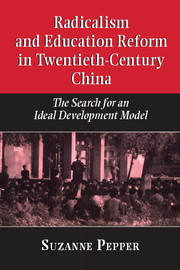Book contents
- Frontmatter
- Contents
- Acknowledgments
- 1 Educational development and the Chinese experience
- Part I The republican era: origins of radical education reform
- Part II Learning from the Soviet Union
- Part III Cultural revolution and radical education reform
- 11 On Stalin, Khrushchev, and the origins of cultural revolution
- 12 The great leap in education
- 13 A system divided: walking on two legs into the 1960s
- 14 Education reform as the catalyst for cultural revolution and class struggle: the 1966–1968 mobilization phase
- 15 Education reform as the culmination of class struggle: the professional educator's perspective
- 16 Education reform as the culmination of class struggle: the critical ideals triumphant at last
- 17 The Cultural Revolution negated
- 18 The mixed triumph of regularity
- 19 Chinese radicalism and education development
- Appendix: the Hong Kong interviews
- Select bibliography
- Index
15 - Education reform as the culmination of class struggle: the professional educator's perspective
Published online by Cambridge University Press: 04 August 2010
- Frontmatter
- Contents
- Acknowledgments
- 1 Educational development and the Chinese experience
- Part I The republican era: origins of radical education reform
- Part II Learning from the Soviet Union
- Part III Cultural revolution and radical education reform
- 11 On Stalin, Khrushchev, and the origins of cultural revolution
- 12 The great leap in education
- 13 A system divided: walking on two legs into the 1960s
- 14 Education reform as the catalyst for cultural revolution and class struggle: the 1966–1968 mobilization phase
- 15 Education reform as the culmination of class struggle: the professional educator's perspective
- 16 Education reform as the culmination of class struggle: the critical ideals triumphant at last
- 17 The Cultural Revolution negated
- 18 The mixed triumph of regularity
- 19 Chinese radicalism and education development
- Appendix: the Hong Kong interviews
- Select bibliography
- Index
Summary
Returning to the basic question posed at the start as to how the Chinese could have declared in 1980 that not one good thing had come from the Cultural Revolution, we can now anticipate the answer. It was not accidental that Mao reminded everyone in 1966 about his early days as a teacher and elementary school headmaster. The lessons learned in those days from the then developing critique of modern schooling had obviously grown into a lifelong commitment. Having adapted the concept of cultural revolution as class struggle to overthrow the education establishment between 1966 and 1968, Mao then spent his remaining years trying to impose what was in essence the old reform ideals upon the entire system. Even one or the other of those two aims – either class struggle or radical across-the-board education reform – would undoubtedly have been enough to provoke a mighty backlash. But to have combined the two ensured that all the enemies Mao created along the way would unite to demolish his grand design.
Nevertheless, for eight years, from 1968 until his death, Mao presided over the most radical set of reforms to be imposed upon China's modern school system since its founding at the turn of the century. And it was this set of reforms that caught the eye and imagination of the international development community. In fact, polemical distortions to the contrary notwithstanding, neither the negative nor the positive claims were overdrawn! We will therefore present the argument from a dual perspective as the worst of times (from the professional educator's viewpoint) and the best of times (for the radical reform ideals).
- Type
- Chapter
- Information
- Radicalism and Education Reform in 20th-Century ChinaThe Search for an Ideal Development Model, pp. 381 - 413Publisher: Cambridge University PressPrint publication year: 1996



